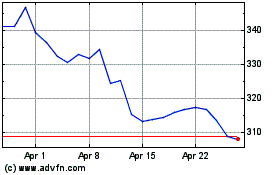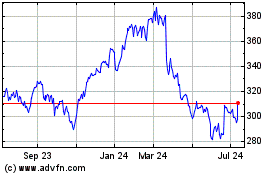Technology Will Help -- And Hurt -- Bank Results, Studies Say
January 18 2017 - 9:38AM
Dow Jones News
By Telis Demos
Some banks may be turning big profits this quarter. But they
will have to spend a lot of money in a gamble to stay profitable as
technology encroaches, according to new set of studies.
McKinsey & Co., in a new report this week, argues that up to
$45 billion of bank profits could be wiped out by 2020 thanks to
encroaching automation, ranging from electronic trading to mobile
banking.
Fees charged for payments like checks and wires, wealth advisory
and management, and consumer banking and lending could each drop by
more than 10% in the U.S. in that time, and more than 20% in the
U.K. and Japan, McKinsey says.
But new technology is also one way to avoid future profit
collapses, another study noted this week.
Accenture PLC, also in a new report this week, estimates that
banks could save $8 billion a year by using the shared databases
known as blockchains, which were invented as a way to track
ownership of bitcoin among a network of individual computers.
Accenture says the costs can come out of the $30 billion
annually spent on trading data, trading compliance and
operations.
McKinsey, in a study presented earlier in January to the U.S.
Treasury, estimated that across all of financial services, using
blockchain in its pure form could save as much as $110 billion
annually globally, with half of that coming from the expense of
cross-border money transfers.
The problem banks face is that they have to commit to spend
money up front, against still theoretical benefits. Already, banks
will directly spend about $130 million in 2016 on blockchain
technology, McKinsey said. That could reach $400 million in two
years.
More broadly, the World Economic Forum, which sponsors this
week's Davos meetings, said that banks are spending an average of
$15 million a year on artificial intelligence -- more than double
what the average company in other sectors does in a year, according
to figures from Infosys, an outsourcing services firm.
The bottom line, according to McKinsey, is that banks will
continue to struggle to cover their cost of capital, which is
roughly 10%. McKinsey projects that year-end 2016 data released by
global banks in coming weeks will show a return-on-equity similar
to 2015, when it was 9.6%.
What that suggests is that despite banks' mostly increasing
profits, they are still doing less with shareholders money than
they did in the past.
Write to Telis Demos at telis.demos@wsj.com
(END) Dow Jones Newswires
January 18, 2017 09:23 ET (14:23 GMT)
Copyright (c) 2017 Dow Jones & Company, Inc.
Accenture (NYSE:ACN)
Historical Stock Chart
From Mar 2024 to Apr 2024

Accenture (NYSE:ACN)
Historical Stock Chart
From Apr 2023 to Apr 2024
